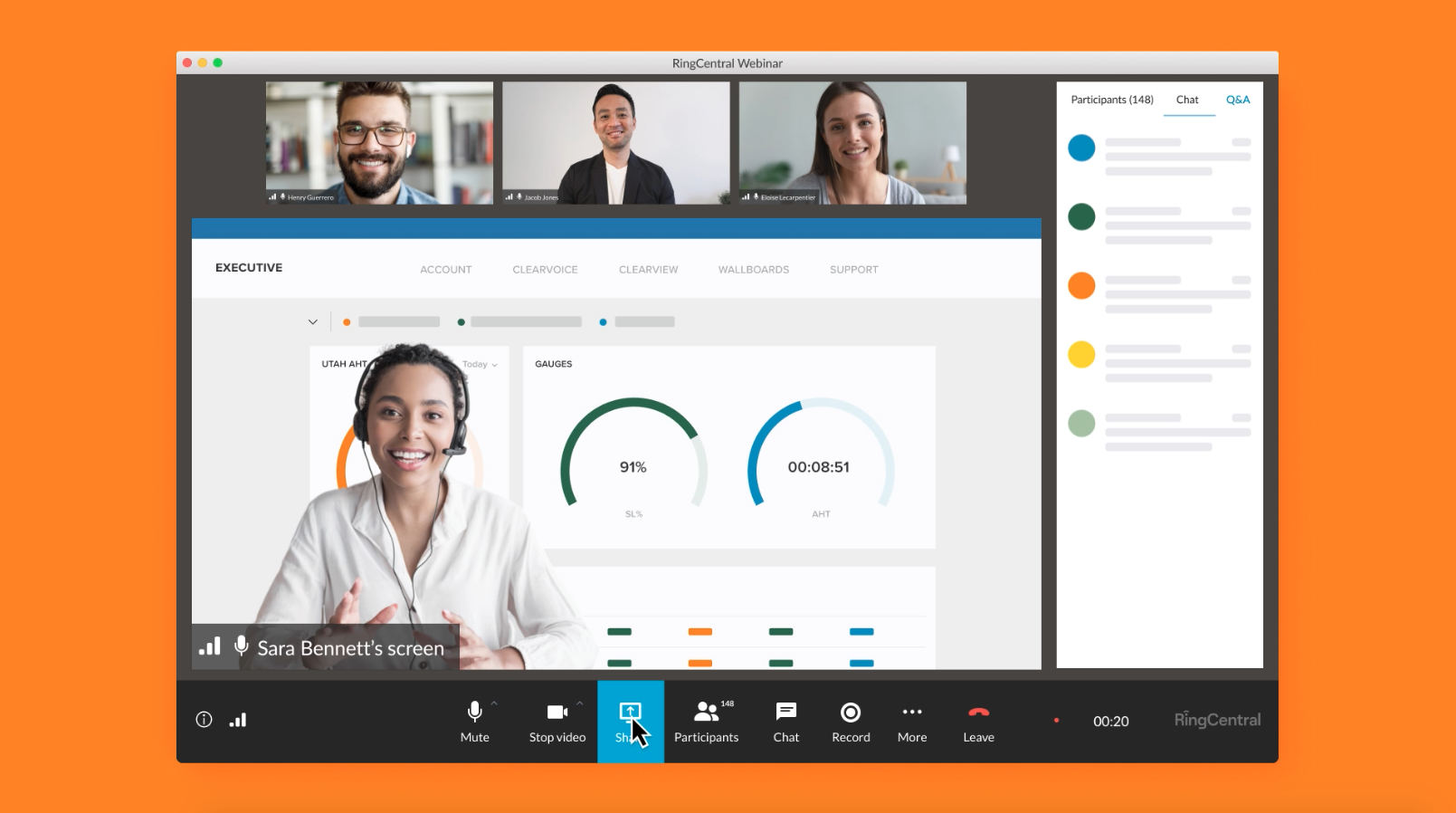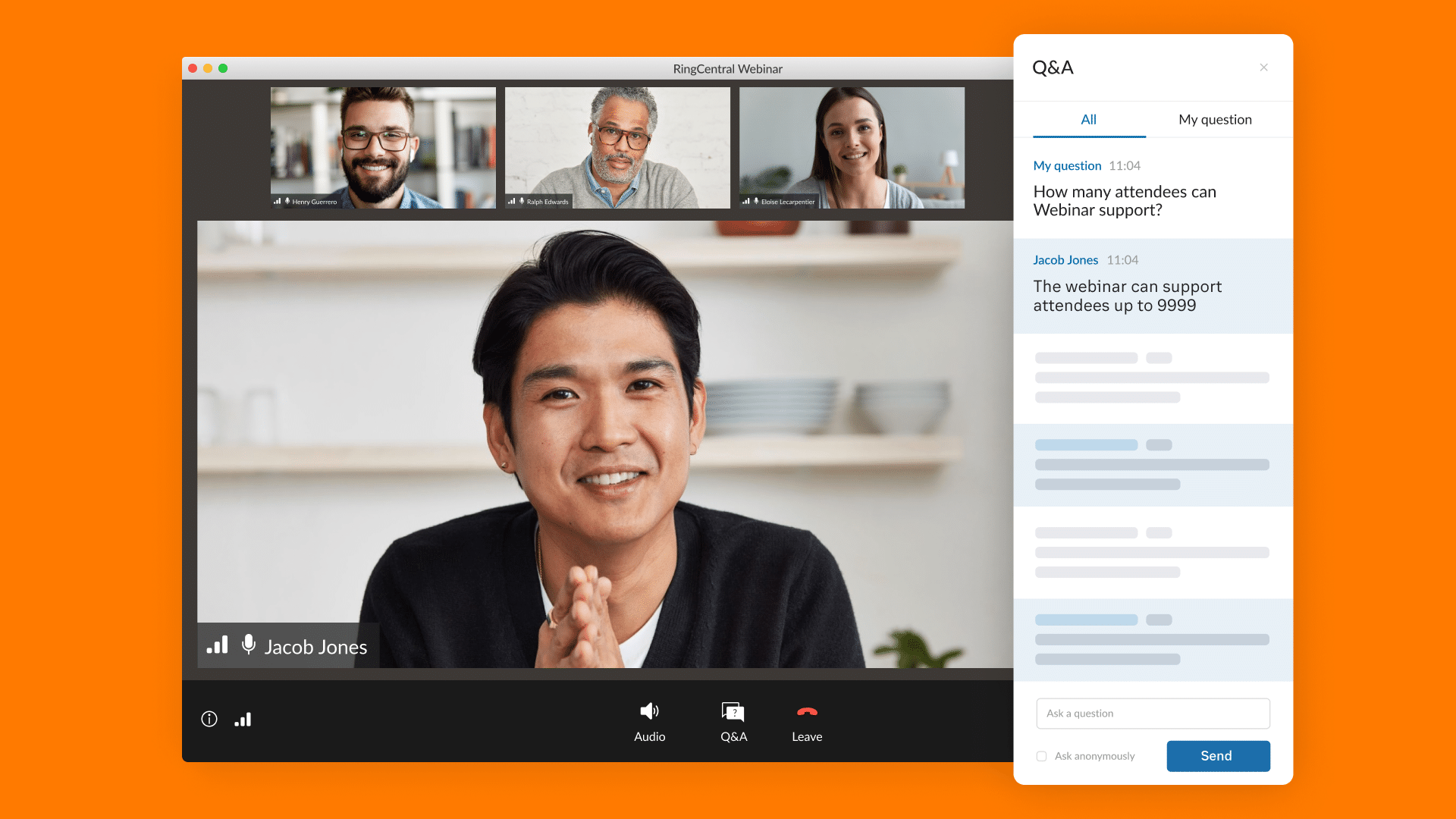Hopin is now RingCentral Events
Hybrid events give you the flexibility to plan incredible experiences for both in-person and virtual participants. In-person and virtual events each have their place, but hybrid events are the only format that provides event professionals with the ability to respond to public health, budgetary, logistical, or environmental concerns that come up while preserving the on-site event experience. They also give organizers room to be creative and establish new standards for what best-in-class events look like.
Read on to find out what you need to know about hybrid events today, and what it takes to successfully execute a hybrid event of your own.
In this guide:
What you need to know about hybrid events
The importance of hybrid events today
Essential elements of a hybrid event
Key considerations for a successful hybrid event
What you need to know about hybrid events
First, let’s lay some groundwork when it comes to hybrid events and how they differ from purely virtual and physical events.
What is a hybrid event?
A hybrid event is a gathering that combines live, in-person interaction with a virtual, online component. The in-person and virtual components can happen simultaneously or at different times. Hybrid events widen an event’s audience by creating two distinct-but-related experiences that meet attendees’ needs.
Best-in-class hybrid events are more than a straight livestream of an in-person event.
They’re carefully planned productions that allow all participants, remote and on site, to interact in an event and engage with one another.
Hybrid events combine the best elements of in-person and virtual events, creating something entirely new.
What are some examples of hybrid events?
There are many different scenarios where hybrid events might be the right call, but most turn to a hybrid solution when:
- They want as many people as possible to be able to participate
- An event is limited by travel restrictions, public health constraints, venue size, sustainability concerns, or another logistical consideration
- There is a need to have a digital version of an in-person event so event content can be recorded and repurposed for marketing or other business needs
Hybrid events can be internal, like a sales kickoff attended by people in the office and at home, or they can be external, with events like public conferences, trade shows, festivals, or sporting events. Some events that work well in a hybrid format are:
- Product launches
- Hackathons
- Global conferences
- Town halls
- Trade shows
There’s no one-size-fits-all hybrid event. When it comes to hybrid, the only limit to an event organizer’s creativity is often their budget.
“We’re actually considering doing an event where everybody starts off online and then we’re looking at doing regional roadshow concepts,” says Karen Hartline, director of corporate events at GitHub.
With minimal hard-and-fast rules at play, event organizers are free to think outside the box when it comes to bringing a hybrid event to life.
How is a hybrid event different from a virtual event?
A virtual event is an organized gathering that brings people together digitally to interact in an online environment. Virtual events differ from hybrid events in that they have no in-person component –– everyone gathers in a digital space.
Online events often make sense when:
- On-site options are too expensive or complex
- Your audience is based around the world
- Enhanced accessibility is needed
- Public health concerns are at play
- There is limited budget or expertise to manage both virtual and in-person components
Virtual events can include events like:
- Webinars
- Hackathons
- Regular team meetings
- Community events such as town halls
How is a hybrid event different from an in-person event?
An in-person event is an organized gathering that brings people together physically to interact in an on-site environment.
In-person events are different from hybrid ones in that they take place entirely in a physical space with no digital component. All attendees participate live which means in-person events are ideal when:
- A core part of your event depends on people connecting face-to-face
- You want the tactile experience –– be it food, drinks, or another collaborative activity –– that only a physical environment can provide
In-person events can include:
- Galas
- C-suite summits
- Team bonding trips
At the end of the day, almost any event can be virtual, in person, or hybrid. Deciding on the format is largely a matter of weighing external and internal factors and determining what’s right for your audience.
The importance of hybrid events today
The rise in virtual events has led to a shift in thinking around traditional in-person events, with 63% of companies hosting hybrid events in 2022.
“I think every in-person event moving forward has to have an online component to it,” Karen says.
The hybrid format is poised to become a fixture of many modern event strategies, in part due to its numerous benefits, including:
- Reach: You can attract a large audience by going hybrid, since the only limitation is your invite list.
- Sponsorship value: A wide reach means increased value for sponsors, with their message being shared more broadly than it would be with just an in-person audience.
- Sustainability: Less travel and less physical waste means less of an environmental footprint.
- Engagement: With added ways for people to come together –– video networking, chat, Q&As, virtual expos, traditional keynotes, and beyond –– hybrid event attendees have a lot of options to connect with one another.
- Accessibility: Hybrid events let attendees join from the comfort of their home (or wherever they may be in the world). Since they can be there from anywhere –– as long as they have an internet connection –– potential attendance barriers like physical ability, cost, and distance are largely taken out of the equation. And with features like closed captioning and simultaneous translation or interpretation, hybrid platforms can help visual- or hearing-impaired attendees participate.
Essential elements of a hybrid event
Planning a hybrid event requires planning two experiences: one virtual and one in person. To start, focus on making sure the following fundamental elements are in place.
Event technology and venue
Choosing your event platform is one of the most important decisions you can make as a hybrid event organizer. You want technology that can span the on-site and online portions of the event and help make the experience cohesive for all participants.
When it comes to your virtual event technology, look for:
- A seamless registration process
- The ability to stream content from the physical venue, ideally with multiple streams happening at once
- A platform that can handle any number of attendees watching a stream at the same time
- An event app built into the technology
- Networking capabilities within the platform
- Chat functionality and the ability to conduct private video calls
- Q&A capabilities
- Extensive branding opportunities
- A variety of plug-ins and integrations, with apps like Snapbar and Kahoot!
- Robust analytics and reporting capabilities
Time zone considerations
Organizing multiple groups can be tricky but a hybrid solution can alleviate some stress. If there’s one time that works for an international audience, you may be able to produce the experience simultaneously.
Another option is to record your content with your live audience and use it to create separate viewing experiences for audiences in different time zones as an on-demand model.
Event team
You’ll need the right team to make your hybrid event a success.
In fact, industry experts say you may even need two teams.
“I really think it’s necessary to have two separate teams –– an online team and an in-person team –– just because of the workload associated with each,” Karen says.
If your budget doesn’t allow for that, make sure your team is fully aware of everything that falls under event management and establish a water-tight game plan for tackling all the necessary responsibilities for both the virtual and in-person components. Here are some examples of things that need to be done to produce a hybrid event:
- Managing registration for virtual and in-person attendees
- Sending invites for both experiences
- Tracking attendee registration status and resending invites as needed
- Designing the virtual and physical venues
- Producing event marketing campaigns
- Creating the event theme and developing branding for the virtual and physical venues
- Producing stage design and signage for the physical venue
- Planning for how venue staff and attendees will navigate any health and safety guidelines and ensuring people adhere to guidelines the day of the event
- Partnering with sponsors and exhibitors to set up their physical and virtual booths
- Creating the virtual venue, including creating stages, sessions, and additional online areas
- Rehearsing with virtual speakers
- Connecting the streaming capabilities at the venue with the virtual platform and ensuring content can be captured
- Ensuring the in-person technology, including lighting, microphones, and streaming capabilities, are running smoothly
- Troubleshooting any technical issues for attendees and speakers
- Moderating and reviewing the live chat
- Managing Q&A
- Ensuring other virtual elements like gamification are working
- Troubleshooting for virtual and physical attendees and speakers the day of the event
Key considerations for a successful hybrid event
When it comes to hybrid events, there are a few common pitfalls to look out for, but planning ahead can help prevent many challenges. Address these key considerations during the planning process to set yourself up for a successful hybrid event.
Registration
Your hybrid event will have two separate portals for registration: one for the virtual component and one for the in-person component. Make sure both are up and running.
You’ll want a fully customizable registration suite for virtual attendees, where you can control and collect information on things like ticket type and pricing.
Your in-person solution should include straightforward ways to check in guests, print badges, and create or edit attendee schedules.
Multi-device accessibility
Hybrid events are all about flexibility.
Having a mobile app helps both physical and virtual attendees stay connected to your event’s content at all times. The app allows attendees to continue tuning into the event –– even if they have to catch the bus or take a break as the live experience is happening.
Speakers
One of the beauties of a hybrid event is that organizers can cast a wide net to find the best speakers.
Virtual technology allows top-tier speakers to join an event at a fraction of the cost and without most of the logistical challenges that come with being there in person. You’ll just need to make sure any virtual speakers have the right set up before they present. Many organizers opt to send speakers tech packs that include lighting, microphones, and detailed instructions on how to add a backdrop, set up technical equipment, and troubleshoot common issues.
In-person speakers will need support too –– from travel and accommodation bookings to day-of management –– plus a quick briefing on how the streaming will work. Introduce them to your streaming software and let them know which camera(s) they should look at for everyone watching remotely.
Content
While much of your event’s content can often be shared across the on-site and virtual experiences, it’s a good idea to have some exclusive content for your virtual audience. This helps online attendees feel tied into the event, even though they’re not physically present.
Exclusive virtual-only content can be dedicated Q&A sessions, roundtables, or VIP networking hours reserved for online attendees.
Adding a high-quality stream of the physical, in-person audience, or even the audio-visual team, can also help make the event experience feel immersive for those joining from home.
Q&A and live poll setup
You want all of your attendees, no matter how they’re joining, to feel like they’re part of the conversation. To achieve that, you’ll want to make sure you have dedicated support across conversational pieces like Q&A sessions and live polls.
For an in-person speaker, your moderator or emcee can often be the liaison between locations, collecting questions from the virtual platform as they come in while also fielding on-site attendee questions.
If you think the volume could be too much for one person, you might want to consider having one person handling inbound questions from virtual attendees and a second person staying on top of questions from in-person attendees. To ensure inclusivity, it’s always best practice to note the name and location of the person asking the question.
For a virtual speaker, make sure an on-site camera is focused on audience members asking questions so the experience is seamless for the speaker and all attendees . For virtual attendees, the speaker can review questions as they come in or the emcee can collect questions and ask them on behalf of audience members.
You can also opt to have virtual attendees join “live” on the screen, whether it’s with an in-person speaker or a virtual one, and ask questions themselves.
Schedule management
In a purely virtual setting, moving from one talk to the next is as simple as a click or tap.
But for a hybrid event, you need to leave time for on-site speakers to swap out and for attendees to get themselves to their next session.
To hold the attention of your virtual audience while that happens, you can show content from your sponsors during those breaks. DJs, comedians, or virtual games, like trivia or quizzes, are also a great option to entertain audiences while they wait for on-site attendees to move locations.
Swag
On-site attendees are used to getting swag: t-shirts, coffee cups, and even branded potato peelers.
Why not make sure your virtual attendees have the same experience? Mail out swag ahead of time so it arrives before your event starts. Then you can have all attendees make use of virtual photo booths to show off their gear — and share that user-generated content on social media or use it in the marketing materials for your next hybrid event.
Networking
Three-quarters of event attendees say networking and making connections is an important part of going to in-person events.
And hybrid events can provide people with incredible opportunities to do just that.
Hybrid events actually offer even more networking opportunities than in-person-only events, since there’s a wider pool of attendees to connect with and technology-enabled ways to “meet” them –– even if they’re not in the same room.
A mobile event app can connect any two attendees, whether they’re onsite or online, and make it easy for them to chat, exchange information, and even schedule follow-ups, if both parties opt in.
And of course in-person attendees can still enjoy face-to-face networking, too.
Health and safety measures
Look at local guidelines where your physical venue is situated and start monitoring them ahead of time to make sure you understand what’s required and can take note of any changes. Things to consider could be fire codes, occupancy limits, Covid-19 protocols, or any other regulations in place.
While regional guidelines and regulations will vary, you can also consider creating your own set of event-specific rules –– that align with local guidelines, of course –– if that makes sense for your audience. Some event professionals have implemented things like proof of vaccination, mask wearing, temperature checks, rapid tests at the door, and branded hand sanitizer or face coverings, for certain experiences.
You also have the option of incorporating event technology that allows for as much contactless attendee management as possible. For example, guests can get badges with QR codes that other attendees can scan to get their information, without needing to exchange physical business cards.
Sponsorship
As an event professional, you want to deliver value to your sponsors. Hybrid events help you double down on that, by giving sponsors a choice of engaging in just one portion of the event (virtual or in person) or expanding their reach by participating in both components.
You can set aside the traditional sponsorship tiers and create a menu of sponsorship options that match the scope and impact of a sponsor’s goals. For instance, if they care most about collecting qualified leads, you can highlight the ability for hybrid sponsors to hold meetings with attendees both virtually and in person.
Analytics
Event analytics can help you optimize your event in real time and report on the event’s impact after it’s over. When your event wraps up, you’ll want to look at all available metrics from both the on-site and online experiences. Naturally, you’ll have more information from the latter since virtual event platforms can highlight things like:
- Popular speakers or sessions
- The number of sponsor engagements
- The number of chats or Q&As sent
- The number of connections made via networking
- And in-depth event reports
Event data can then feed into your post-event report for sponsors and stakeholders, as well as your planning sessions for future events.
The future of hybrid events
There’s a time and place for every event format. But if you’re looking to create a more flexible event that meets attendees where they are and contributes to new standards for what best-in-class shared experiences look like, a hybrid event might just be the way to go.
Contact us today to learn how RingCentral Events technology can help power your next hybrid experience.
Originally published Sep 01, 2022, updated Oct 20, 2024





